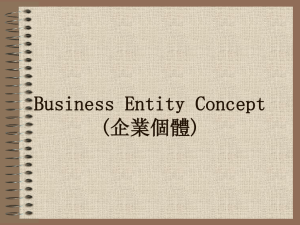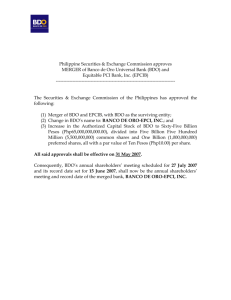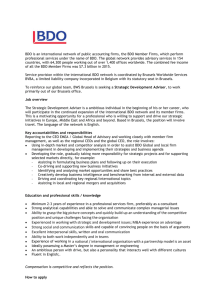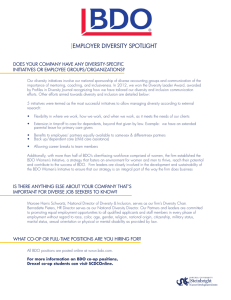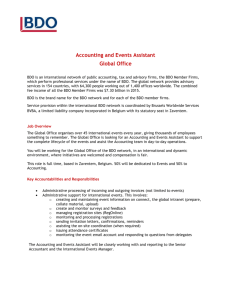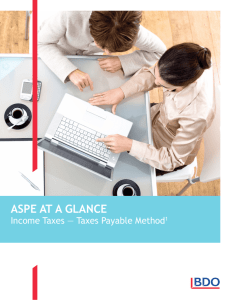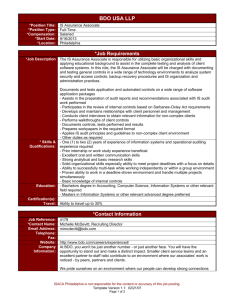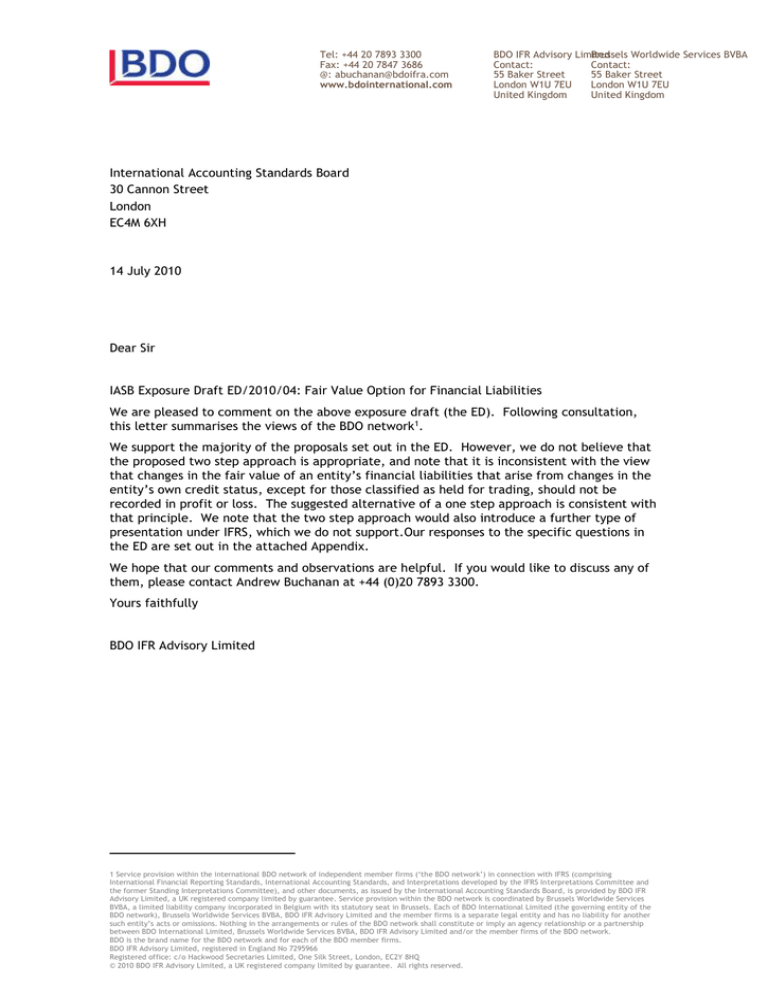
Tel: +44 20 7893 3300
Fax: +44 20 7847 3686
@: abuchanan@bdoifra.com
www.bdointernational.com
BDO IFR Advisory Limited
Brussels Worldwide Services BVBA
Contact:
Contact:
55 Baker Street
55 Baker Street
London W1U 7EU
London W1U 7EU
United Kingdom
United Kingdom
International Accounting Standards Board
30 Cannon Street
London
EC4M 6XH
14 July 2010
Dear Sir
IASB Exposure Draft ED/2010/04: Fair Value Option for Financial Liabilities
We are pleased to comment on the above exposure draft (the ED). Following consultation,
this letter summarises the views of the BDO network1.
We support the majority of the proposals set out in the ED. However, we do not believe that
the proposed two step approach is appropriate, and note that it is inconsistent with the view
that changes in the fair value of an entity’s financial liabilities that arise from changes in the
entity’s own credit status, except for those classified as held for trading, should not be
recorded in profit or loss. The suggested alternative of a one step approach is consistent with
that principle. We note that the two step approach would also introduce a further type of
presentation under IFRS, which we do not support.Our responses to the specific questions in
the ED are set out in the attached Appendix.
We hope that our comments and observations are helpful. If you would like to discuss any of
them, please contact Andrew Buchanan at +44 (0)20 7893 3300.
Yours faithfully
BDO IFR Advisory Limited
1 Service provision within the international BDO network of independent member firms (‘the BDO network’) in connection with IFRS (comprising
International Financial Reporting Standards, International Accounting Standards, and Interpretations developed by the IFRS Interpretations Committee and
the former Standing Interpretations Committee), and other documents, as issued by the International Accounting Standards Board, is provided by BDO IFR
Advisory Limited, a UK registered company limited by guarantee. Service provision within the BDO network is coordinated by Brussels Worldwide Services
BVBA, a limited liability company incorporated in Belgium with its statutory seat in Brussels. Each of BDO International Limited (the governing entity of the
BDO network), Brussels Worldwide Services BVBA, BDO IFR Advisory Limited and the member firms is a separate legal entity and has no liability for another
such entity’s acts or omissions. Nothing in the arrangements or rules of the BDO network shall constitute or imply an agency relationship or a partnership
between BDO International Limited, Brussels Worldwide Services BVBA, BDO IFR Advisory Limited and/or the member firms of the BDO network.
BDO is the brand name for the BDO network and for each of the BDO member firms.
BDO IFR Advisory Limited, registered in England No 7295966
Registered office: c/o Hackwood Secretaries Limited, One Silk Street, London, EC2Y 8HQ
© 2010 BDO IFR Advisory Limited, a UK registered company limited by guarantee. All rights reserved.
Appendix
Question 1
Do you agree that for all liabilities designated under the fair value option, changes in
the credit risk of the liability should not affect profit or loss? If you disagree, why?
We agree that recognising changes in the fair value of an entity’s financial liabilities in profit
or loss that arise from changes in the entity’s own credit status does not provide decision
useful information, other than where financial liabilities are held for trading.
Question 2
Or alternatively, do you believe that changes in the credit risk of the liability should not
affect profit or loss unless such treatment would create a mismatch in profit or loss (in
which case the entire fair value change would be required to be presented in profit or
loss)? Why?
We do not believe that changes in the fair value of an entity’s financial liabilities arising from
changes in the entity’s own credit risk should be recognised in profit or loss, for the reasons
set out in our response to question 1 above.
Question 3
Do you agree that the portion of fair value change that is attributable to changes in the
credit risk of the liability should be presented in other comprehensive income? If not,
why?
We agree, and note that an entity’s financial performance is often judged by its recorded
profit or loss. For non-trading liabilities, recording profit as an entity’s credit status
deteriorates and the fair value of its financial liabilities declines, and losses as its credit
status improves and the fair value of its liabilities increases, does not provide decision useful
information. However, while we support the proposed approach, we believe that it again
highlights a distinction between amounts recorded in profit or loss and amounts recorded in
other comprehensive income. While this may be appropriate, we would encourage the Board
to carry out further analysis of what should be included in each section of the statement of
comprehensive income with a view to establishing a principle to be applied in determining
whether amounts should be recognised in profit or loss, or other comprehensive income.
Question 4
Do you agree that the two-step approach provides useful information to users of
financial statements? If not, what would you propose instead and why?
We do not agree. As noted above, we do not consider that the inclusion of changes in the fair
value of an entity’s financial liabilities in profit or loss that arise from changes in the entity’s
credit status provides decision useful information. In addition, we consider that the two-step
approach, of first including all changes in the fair value of an entity’s financial liabilities in
profit or loss and then backing out changes in fair value for non trading financial liabilities
that arise from changes in credit status and taking these to other comprehensive income,
would introduce unnecessary complexity and clutter to profit or loss, and could lead to
questions about whether profit or loss before or after the inclusion of credit related fair value
changes is the appropriate measure to focus on.
If the Board considers that information that does combine the effect of all changes in the fair
value of an entity’s financial liabilities, including those arising from changes in credit status,
is useful then this information should be included within the notes.
Question 5
Do you believe that the one-step approach is preferable to the two-step approach? If
so, why?
Yes, we believe that the one-step approach is preferable to the two-step approach, for the
reasons set out in our response to question 4.
Question 6
Do you believe that the effects of changes in the credit risk of the liability should be
presented in equity (rather than in other comprehensive income)? If so, why?
No, we do not believe that the effects of changes in the credit risk of the liability should be
presented in equity. Transactions should be included directly in equity only where they arise
from transactions with owners in their capacity as such, and not gains or losses arising from
transactions with other parties.
Question 7
Do you agree that gains or losses resulting from changes in a liability’s credit risk
included in other comprehensive income (or included in equity if you responded ‘yes’ to
Question 6) should not be reclassified to profit or loss? If not, why and in what
circumstances should they be reclassified?
We agree that gains or losses resulting from changes in a liability’s credit risk that are
included in other comprehensive income should not be reclassified to profit or loss, and note
that this is consistent with the approach followed in IFRS 9 for equity instruments that are
classified as at Fair Value Through Other Comprehensive Income. In principle, we believe
that gains and losses should be recognised only once in the primary financial statements.
We also agree with the Board’s conclusions set out in paragraph BC39.
Question 8
For the purposes of the proposals in this exposure draft, do you agree that the guidance
in IFRS 7 should be used for determining the amount of the change in fair value that is
attributable to changes in a liability’s credit risk? If not, what would you propose
instead and why?
We agree that the guidance in IFRS 7 should be used, and that the default method set out in
that standard provides a reasonable proxy for changes in the fair value of a financial liability
arising from changes in an entity’s own credit risk. We note that IFRS 7 also permits an entity
to use a different method for determining the portion of the change in fair value of its
financial liabilities that is attributable to changes in the entity’s credit risk, if this provides a
more faithful representation of such changes, meaning that a more sophisticated method can
be used if considered appropriate.
We note that IFRS 7.10(a) gives examples of changes in market conditions that give rise to
market risk, which include ‘changes in a benchmark interest rate, the price of another
entity’s financial instrument, a commodity price, a foreign exchange rate or an index of
prices or rates’. It would be helpful for further guidance to be included, clarifying what the
Board means by the ‘benchmark approach’ and the associated rates that are being referred
to, together with some examples of market variables.
Question 9
Do you agree with the proposal related to early adoption? If not, what would propose
instead and why? How would those proposals address concerns about comparability?
We agree that early adoption should be permitted, and also agree that all of the other
requirements set out in IFRS 9 should be required to be adopted at the same time if the
proposals are taken forward and finalised. We believe that this would assist in reducing the
potential for entity’s to ‘cherry pick’ their timing of adoption of various requirements, and
that the consistency of the date of initial application would enhance comparability among
different entities.
Question 10
Do you agree with the proposed transition requirements? If not, what transition
approach would you propose instead and why?
We agree that the amendments should be applied retrospectively, and note that the required
information should already have been obtained in order for the entity to comply with the
requirements of IFRS 7. However, we note that this may be complex for some entities, as it
would appear that deferred tax adjustments arising from changes in the recorded fair value
of the related financial liabilities will need to be split between profit or loss, and other
comprehensive income.


